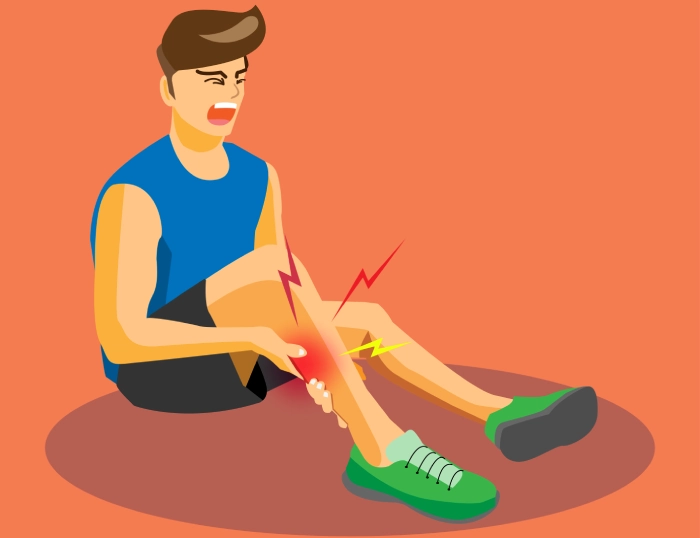Hey there, health enthusiasts and leg pain sufferers! Today, we’re diving deep into the world of policosanol for leg pain. Buckle up, because we’re about to embark on a journey that’ll have your legs jumping for joy (well, maybe not literally, but you get the idea).
What is Policosanol? The Superhero Your Legs Didn’t Know They Needed
So, what exactly is policosanol? No, it’s not a fancy cocktail or a new dance move. Policosanol is a natural compound derived from sugar cane wax, though it can also be found in other plants like wheat germ and beeswax. It’s like the Clark Kent of supplements – unassuming at first glance, but packing a serious punch when it comes to health benefits.
Now, you might be wondering, “Why should I care about policosanol for leg pain?” Well, my friend, let me tell you – this little superhero might just be the answer to your achy, breaky legs. But before we dive into the nitty-gritty, let’s break down what policosanol is all about.
The ABCs of Policosanol
Policosanol is a mixture of long-chain alcohols, including octacosanol, triacontanol, and hexacosanol. Don’t worry; I won’t quiz you on these names later. What’s important is that these compounds work together like the Avengers of the supplement world, fighting off various health villains.
But here’s where it gets interesting: policosanol for leg pain isn’t just a one-trick pony. Oh no, this supplement is a multi-tasking marvel that’s been studied for its potential benefits in various areas of health. Let’s break it down, shall we?
The Benefits of Policosanol: More Than Just Leg Pain Relief

- Cholesterol Control: One of the most well-known benefits of policosanol is its potential to help manage cholesterol levels. Studies have shown that policosanol for cholesterol management can be quite effective. It’s like a tiny traffic cop, directing your lipid levels to behave themselves.
- Heart Health Hero: By extension, policosanol’s cholesterol-lowering properties make it a potential ally for heart health. It’s like giving your heart a little superhero sidekick.
- Circulation Sensation: Improved blood flow is another potential benefit, which is where policosanol for leg pain really shines. It’s like giving your circulatory system a much-needed spa day.
- Antioxidant Action: Policosanol has antioxidant properties, fighting off those pesky free radicals. Think of it as your body’s personal bodyguard.
- Weight Management Wonder: Some studies suggest policosanol for weight loss might be worth exploring. It’s not a miracle fat-burner, but hey, every little bit helps, right?
Now, let’s zoom in on what you’ve all been waiting for – how policosanol can potentially help with leg pain.
Policosanol for Leg Pain: Your Limbs’ New Best Friend?
Leg pain can be a real party pooper, am I right? Whether it’s from long hours on your feet, intense workouts, or circulation issues, nobody likes feeling like their legs are staging a revolt. This is where policosanol for leg pain steps into the spotlight.
How does it work, you ask? Well, it’s all about that blood flow, baby! Policosanol is thought to improve circulation by helping to dilate blood vessels and reduce the stickiness of blood platelets. In simpler terms, it’s like turning your blood vessels from cramped city alleys into smooth-flowing highways.
This improved circulation can potentially help with:
- Reducing muscle cramps and fatigue
- Alleviating pain from poor circulation
- Improving overall leg comfort and mobility
But hold your horses! Before you go galloping off to buy all the policosanol supplements you can find, let’s talk dosage.
Finding Your Policosanol Sweet Spot
When it comes to policosanol, more isn’t always better. The typical dosage ranges from 5 to 20 mg per day. Many studies have used policosanol 20 mg as their go-to dose, showing promising results for various health benefits, including potential leg pain relief.
But here’s the kicker – some research suggests that policosanol 40mg might be even more effective for certain conditions. However, it’s crucial to remember that higher doses aren’t necessarily better for everyone and could increase the risk of side effects.
Side Effects of Policosanol: The Not-So-Fun Part
Speaking of side effects, let’s address the elephant in the room. While policosanol is generally considered safe for most people, it’s not without its potential downsides. Some reported side effects of policosanol include:
- Skin rashes
- Headaches
- Dizziness
- Upset stomach
- Insomnia
- Increased appetite
- Weight gain (ironically, given its potential use for weight loss)
- Changes in blood sugar levels
It’s also worth noting that policosanol may interact with blood-thinning medications, so if you’re on any of those, have a chat with your doc before jumping on the policosanol bandwagon.
Policosanol and Thyroid: A Delicate Dance
Now, here’s an interesting tidbit – there’s been some buzz about policosanol and thyroid function. While research is limited, some studies suggest that policosanol might influence thyroid hormone levels. If you’re dealing with thyroid issues, it’s extra important to consult with your healthcare provider before adding policosanol to your routine.
The Best Policosanol Supplement: Choosing Your Leg Pain Warrior
Alright, so you’re sold on giving policosanol a try. But with so many options out there, how do you choose the best policosanol supplement? Here are a few tips:
- Look for reputable brands: Companies like Solgar policosanol have a good track record.
- Check the dosage: Remember, policosanol 20mg is a common and well-studied dose.
- Read the ingredients: Make sure you’re not getting a bunch of unnecessary fillers.
- Consider the source: Sugar cane-derived policosanol is the most studied form.
Policosanol Supplement Showdown: Pills vs. Powders
When it comes to taking your policosanol, you’ve got options. Pills are convenient and easy to dose, while powders offer flexibility in how you consume them. Some brave souls even go for sublingual absorption. Whatever floats your boat (or soothes your legs), just make sure you’re consistent with your dosage.
The Policosanol Lifestyle: More Than Just a Pill
Here’s the thing, folks – policosanol for leg pain isn’t a magic bullet. It’s part of a broader approach to leg health and overall well-being. To get the most out of your policosanol supplement, consider:
- Staying hydrated: Water is your legs’ best friend.
- Moving regularly: Don’t let those legs get too comfy.
- Eating a balanced diet: Fuel your body right.
- Managing stress: Your legs feel it too!
How to Incorporate Policosanol into Your Routine
Ready to give policosanol a whirl? Here are some tips to get you started:
- Start low and go slow: Begin with a lower dose and gradually increase if needed.
- Be consistent: Take your policosanol supplement at the same time each day.
- Pair with healthy fats: Some studies suggest this might improve absorption.
- Give it time: Don’t expect overnight miracles. Give it at least a few weeks to see potential benefits.
Policosanol for Leg Pain: Real Talk

Let’s get real for a moment. While policosanol for leg pain shows promise, it’s not a guaranteed cure-all. Everyone’s body is different, and what works wonders for one person might not do much for another. That’s why it’s crucial to approach policosanol with realistic expectations and a healthy dose of skepticism.
That being said, many people have reported positive experiences with policosanol for leg pain. Some users have noticed reduced cramping, improved circulation, and overall better leg comfort. But remember, these are anecdotal reports, and your mileage may vary.
The Science Behind Policosanol for Leg Pain
While we’re on the topic of evidence, let’s dive into what the science says about policosanol for leg pain. Research in this specific area is limited, but studies on policosanol’s effects on circulation and cardiovascular health provide some insight into how it might help with leg pain.
A few studies have shown that policosanol can improve walking distance in people with intermittent claudication, a type of leg pain caused by poor circulation. This suggests that policosanol for leg pain might be particularly beneficial for those with circulation-related discomfort.
Policosanol 20mg: The Golden Dose?
You might have noticed that policosanol 20mg is often mentioned as a standard dose. But why is that? Well, many of the studies showing positive effects of policosanol, including those related to circulation and cholesterol management, used this dosage. That’s why policosanol 20mg has become something of a go-to in the supplement world.
However, it’s important to note that some people might benefit from lower or higher doses. Always start with the lowest effective dose and consult with a healthcare professional before increasing your intake.
Policosanol 40mg: More Power or More Problems?
While policosanol 20mg is the most common dose, some studies have explored the effects of policosanol 40mg. This higher dose has shown potential for more pronounced effects, particularly in cholesterol management. However, it’s crucial to remember that higher doses also come with an increased risk of side effects.
If you’re considering policosanol 40mg, it’s absolutely essential to discuss this with your healthcare provider first. They can help you weigh the potential benefits against the risks based on your individual health profile.
The Best Policosanol Supplement: What to Look For
When shopping for the best policosanol supplement, keep these factors in mind:
- Purity: Look for products that contain pure policosanol without unnecessary additives.
- Source: Sugar cane-derived policosanol is the most studied form.
- Dosage: Make sure the product offers the dose you’re looking for (often policosanol 20mg).
- Third-party testing: Choose supplements that have been tested for quality and purity by independent labs.
- Reputation: Opt for well-established brands with good customer reviews.
Solgar Policosanol: A Popular Choice
One brand that often comes up in discussions about policosanol is Solgar. Solgar policosanol has gained a reputation for quality and effectiveness. However, it’s important to remember that while brand reputation is important, it shouldn’t be the only factor in your decision-making process.
Policosanol for Weight Loss: Managing Expectations

While we’re primarily focusing on policosanol for leg pain, it’s worth addressing the buzz around policosanol for weight loss. Some studies have suggested that policosanol might have a modest effect on weight management, possibly due to its impact on lipid metabolism.
However, it’s crucial to manage your expectations. Policosanol is not a magic weight loss pill. If you’re considering policosanol for weight loss, remember that it should be part of a comprehensive approach that includes a healthy diet and regular exercise.
Policosanol Supplement: How to Take It
When it comes to taking your policosanol supplement, consistency is key. Here are some tips:
- Timing: Some people prefer to take policosanol with their evening meal, as some studies have used this timing.
- Absorption: Taking policosanol with a small amount of healthy fat might improve absorption.
- Consistency: Try to take your supplement at the same time each day to maintain steady levels in your system.
Remember, when using policosanol for leg pain or any other purpose, patience is crucial. It may take several weeks of consistent use before you notice any effects.
The Future of Policosanol for Leg Pain
As research continues, we may gain more insights into the effectiveness of policosanol for leg pain and other health concerns. For now, while the evidence is promising, it’s important to approach policosanol with a balanced perspective.
Policosanol isn’t a miracle cure, but it might be a helpful tool in your leg health toolkit. Combined with other healthy lifestyle choices, policosanol for leg pain could potentially contribute to improved comfort and mobility.
The Final Stretch: Wrapping Up Our Policosanol Journey
We’ve covered a lot of ground in our exploration of policosanol for leg pain. From understanding what policosanol is to diving into its potential benefits, dosage considerations, and possible side effects, you’re now armed with a wealth of information to make an informed decision about whether policosanol might be right for you.
Remember, while policosanol shows promise for leg pain and various other health benefits, it’s not a substitute for a healthy lifestyle or medical advice. Always consult with your healthcare provider before starting any new supplement regimen, especially if you have existing health conditions or are taking medications.
So, are you ready to give your legs a little policosanol love? Who knows, you might just find yourself doing the happy leg dance sooner than you think. And hey, even if it doesn’t work miracles, at least you can say you tried something with a cool name like “policosanol.” That’s gotta count for something, right?
Until next time, keep those legs moving, stay curious about your health, and remember – every step counts, even if it’s a wobbly one. Here’s to happy, healthy legs and the endless pursuit of wellness!



